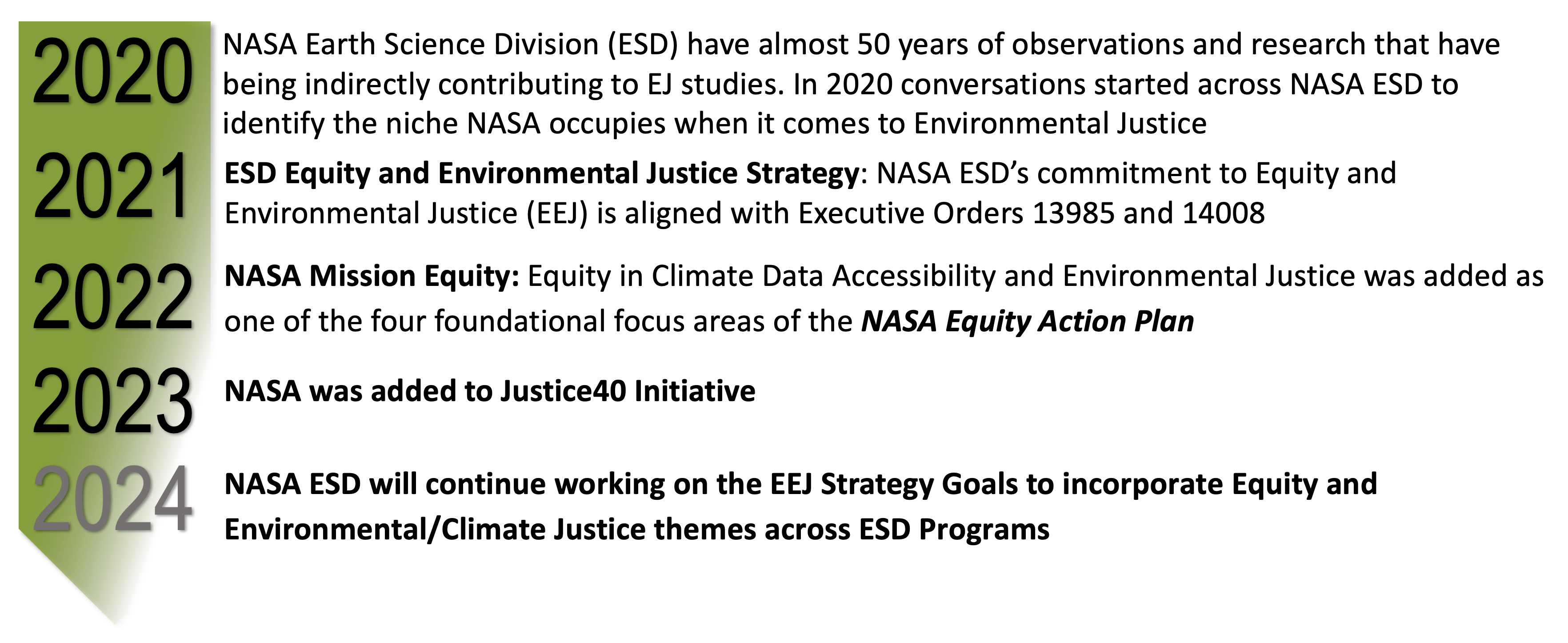Overview
NASA's Earth Science Division (ESD) not only aims to diversify Earth science research and applications communities with representation from all backgrounds, but also support Environmental Justice (EJ) communities by expanding awareness, accessibility, and use of Earth science data and enabling contributions to Earth science research and applications.
ESD is committed to ensuring that the investment the nation has made in NASA satellites and science benefits people across the U.S. and helps them make informed decisions about the very real challenges they face in their communities.
To begin addressing these goals, outlined below, ESD projects and developed resources, including current opportunities are populated below and linked by type in this section.

Five goals frame ESD’s Equity and Environmental Justice Strategy:
- Assess ongoing environmental justice engagements, barriers, gaps, and opportunities.
- Engage with EJ organizations to harvest lessons and build potential partnerships.
- Host data accessibility and utility sessions.
- Enable transdisciplinary science and applications that integrate physical and social science using NASA datasets.
- Incorporate EEJ and Climate Justice themes across the Earth Science Division

Listening Sessions
ESD and NASA’s Socioeconomic Data and Applications Center (SEDAC) organized their first community listening workshop on Oct. 20, 2021. Titled "NASA’s Equity and Environmental Justice Virtual Workshop,” the workshop featured representatives from social science research organizations who engage with environmental justice research and communities. Results and recommendations from the workshop informed the NASA EEJ Strategy.
The Understanding Needs to Broaden Outside Use of NASA Data (UNBOUND) project seeks to make NASA data, tools, and resources more usable and accessible to a broader community. UNBOUND project employs a series of coordinated domain-specific workshops designed to match influential analysis and visualization practitioners in target communities with NASA data scientists and others knowledgeable in the field. This collaboration will help define barriers to using these data and implement high-impact activities that will put NASA data at the forefront of policy decisions and dramatically broaden the use of NASA Earth Science data in communities outside of the NASA research community. Previous related topics include Tribal Food, Energy, and Water Priorities; Coastal Issues; Air Quality; and Environmental Justice.
Solicited Projects
On Dec. 8, 2021, ESD released the first dedicated funding opportunity for Equity and Environmental Justice work through Research Opportunities in Space and Earth Science (ROSES)-2021, A.49 Earth Science Applications: Equity and Environmental Justice, to advance progress on equity and environmental justice (EEJ) domestically through the application of Earth science, geospatial, and socioeconomic information. This solicitation includes three elements: 1.) Landscape analyses, 2.) Community-based feasibility projects, and 3.) Data integration projects that combine Earth science information and socioeconomic datasets. The solicitation resulted in 39 funded projects supported through Earth Action.
These projects, selected in August 2023, were designed to address questions at the intersection of Earth observations and environmental/climate justice. The Interdisciplinary research opportunity supports research and application communities to work across social science disciplines to address complex and challenging problems that are relevant to environmental and climate justice communities worldwide.
ESDS is supporting multiple EEJ data projects to Advancing Gulf Coast Environmental Justice and Leadership and Engagement in Open Science (AGEJLE-OS).
Identifies, develops, and supports adoption of software and information systems, as well as novel computer science technologies. Three recent AIST projects relate to EEJ, including projects related to coastal water quality; neighborhood climate risk, and urban exposure; and coastal resiliency in the project Pixels for Public Health: Analytic Collaborative Framework to Enhance Coastal Resiliency of Vulnerable Populations in Hampton Roads, Virginia.
Supports work that addresses EEJ through urbanization. By leveraging high spectral and spatial resolution thermal infrared data from the Hyperspectral Thermal Emission Spectrometer (HyTES), researchers can determine the properties of the Earth’s surface at the street scale of urban areas. This work will generate an Urban Compositional Map over the Los Angeles area and will demonstrate an approach to understand the spatially variable impact of urbanization on the properties of the Earth’s surface, and by extension the impact on the people living in those environments.
EJ Community Resources
NASA’s Earth Science Data Systems (ESDS) Program has compiled an Environmental Justice Data Backgrounder with information about how NASA data are being used to support environmental and climate justice efforts along with use cases showing how scientists and decision-makers are applying a wide combination of datasets to assess the vulnerability and exposure of communities to environmental challenges.
The NASA Earth Science Data Systems (ESDS) Program’s Environmental Justice Data Catalog is your guide to datasets that may be useful in environmental justice research. This guide shares datasets that may be useful in EJ research, and are organized by topic, such as disasters, urban flooding, extreme heat, food availability, water availability, climate, and health and air quality, and the possible use cases for each dataset.
In Spring 2024, the EJ Data Catalog will be incorporated on the Science Discovery Engine which is currently in beta. It operates as an open-source science infrastructure to enable collaborative and interdisciplinary science. The Science Discovery Engine includes a vast collection of NASA’s science data, documentation, and code. Search results may include links to datasets, models, images, videos, software, or data analysis tools. The results can be filtered by associated missions, instruments, or branches of science.
ESDS also has a number of Data Pathfinders that guide users through the process of selecting application-specific datasets and learning how to use them through intuitive tools.
NASA’s Visualization, Exploration, and Data Analysis (VEDA) is an open-source science cyberinfrastructure for data processing, visualization, exploration, and geographic information systems (GIS) capabilities. Developed collaboratively and mostly reusing existing open-source components, VEDA consolidates GIS delivery mechanisms, processing platforms, analysis services, and visualization tools and provides an ecosystem of open tools for addressing Earth science research and application needs through the public-facing VEDA dashboard, which features EJ stories.
ARSET provides free, online trainings led by subject matter experts on a variety of topics from beginner to advanced levels. ARSET trainings are often multi-lingual and cover EJ topics including air quality, water quality, urban heat, and more. For example, this training, developed in collaboration with the Health and Air Quality Science Team (HAQAST) SD4EJ Tiger Team, demonstrates how remotely-sensed air pollution information can be paired with demographic data to understand disproportionate exposures among minoritized and marginalized population subgroups.
NASA’s Equity and Environmental Justice program releases a monthly newsletter with the latest from the program, other NASA opportunities and resources, and other news from the environmental justice field.
Read past issues on the EEJ program webpage.
Current Funding Opportunities
On Dec. 14, 2023, ESD released the latest call for funding through Research Opportunities in Space and Earth Science (ROSES)-23, A.47 Earth Action: Community Action for Equity and Environmental Justice. Through this call, NASA seeks to advance EEJ through the creation of geospatial tools that integrate Earth science and socio-economic information, expand the communities of practice that use Earth observations to address environmental justice issues, and inform action.
Final proposals are due March 14, 2024.
On Dec. 14, 2023, ESD released a call for funding through Research Opportunities in Space and Earth Science (ROSES)-2023, A.67: Supporting Climate Resilient Communities. This call for proposals aims to increase the use of NASA Earth observations to support community resilience, expand the communities of practice who use NASA Earth observations to develop climate-informed community resilience decisions, demonstrate the value of using NASA Earth observations to prepare for and respond to climate change, and inform NASA’s future strategic engagement and activities on climate resilience. Proposals must engage communities in advancing climate-informed decisions that enhance their resilience to the impacts of climate change and involve organizations that assist in knowledge sharing between scientists and decision makers.
NOIs are requested by February 23, 2024 and proposals are due by May 3, 2024.
On February 14, 2023, the Science Mission Directorate (SMD) solicited proposals for F.5 FINESST from accredited U.S. universities and other eligible organizations for research projects that contribute to SMD's science, technology and exploration goals. NASA's Earth Science Division (ESD) solicits proposals to answer the biggest questions about how our planet is changing now and how Earth could change in the future to provide societal benefit. ESD is accepting EJ and Climate related projects.
EARTH23 FINESST Proposals Due February 6, 2024.
Additional ESD Missions and Projects that support EEJ
The Earth Science Division supports other missions and projects that include Equity and Environmental Justice topics which are aligned with goal number 5: Incorporate EEJ and Climate Justice themes across the Earth Science Division.

NASA DEVELOP National Program
The experiential workforce development program that pairs interdisciplinary teams of participants with partner organizations to use NASA Earth observations to address an environmental question. The teams spend 10 weeks working with science advisors and partners to develop and complete the project, then hand it over to the end user at the end of the term. Some projects work with environmental justice organizations or address environmental equity concerns. DEVELOP generally hosts three terms each year in spring, summer, and fall. More information about eligibility and partnering with DEVELOP can be found on their website.

The Health and Air Quality Applied Sciences Team (HAQAST)
Supports a project entitled Satellite Data for Environmental Justice (SD4EJ), which aimed to integrate satellite data into environmental justice (EJ) screening and mapping tools.

Transform to Open Science (TOPS)
The 5-year mission to accelerate adoption of open science to increase understanding and adoption of open science principles and techniques, broaden participation by historically excluded communities, and accelerate major scientific discoveries. Open Science 101 is a community-developed introduction to open science with inclusivity, accessibility, and diversity at the forefront. You can register for in-person or virtual live training or complete a self-paced curriculum

The U.S. Greenhouse Gas Center
The hub for collaboration between agencies across the U.S. government as well as non-profit and private sector partners. Data, information, and computer models from observations from the International Space Station, various satellite and airborne missions, and ground stations are available online. The center’s data catalog includes a curated collection of data sets that provide insights into greenhouse gas sources, sinks, emissions, and fluxes. Initial information in the center website is focused on three areas; estimates of greenhouse gas emissions from human activities, naturally occurring greenhouse gas sources and sinks on land and in the ocean, and large methane emission event identification and quantification, leveraging aircraft and space-based data.




